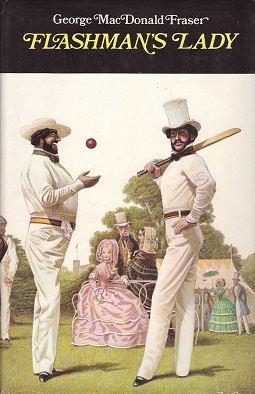
Sir Harry Paget Flashman is a fictional character created by Thomas Hughes (1822–1896) in the semi-autobiographical Tom Brown's School Days (1857) and later developed by George MacDonald Fraser (1925–2008). Harry Flashman appears in a series of 12 of Fraser's books, collectively known as The Flashman Papers, with covers illustrated by Arthur Barbosa and Gino D’Achille. Flashman was played by Malcolm McDowell in the Richard Lester 1975 film Royal Flash.

George MacDonald Fraser was a Scottish author and screenwriter. He is best known for a series of works that featured the character Flashman. Over the course of his career he wrote eleven novels and one short-story collection in the Flashman series of novels, as well as non-fiction, short stories, novels and screenplays—including those for the James Bond film Octopussy, The Three Musketeers and an adaptation of his own novel Royal Flash.

Tom Brown's School Days is a novel by Thomas Hughes, published in 1857. The story is set in the 1830s at Rugby School, an English public school. Hughes attended Rugby School from 1834 to 1842.

Royal Flash is a 1975 British adventure comedy film based on the second Flashman novel by George MacDonald Fraser. It stars Malcolm McDowell as Flashman. Additionally, Oliver Reed appeared in the role of Otto von Bismarck, Alan Bates as Rudi von Sternberg, and Florinda Bolkan played Lola Montez. Fraser wrote the screenplay and the film was directed by Richard Lester.
Tom Brown is a fictional character created by author Thomas Hughes in his work Tom Brown's School Days (1857) which is set at a real English public school—Rugby School for Boys—in the 1830s when Hughes himself had been a pupil there. Tom Brown is based on the author's brother, George Hughes, and George Arthur is based on Arthur Penrhyn Stanley.

Flashman is a 1969 novel by George MacDonald Fraser. It is the first of the Flashman novels.

Flash for Freedom! is a 1971 novel by George MacDonald Fraser. It is the third of the Flashman novels.

Flashman at the Charge is a 1973 novel by George MacDonald Fraser. It is the fourth of the Flashman novels. Playboy magazine serialised Flashman at the Charge in 1973 in their April, May and June issues. The serialisation is unabridged, including most of the notes and appendixes, and features a few illustrations, collages from various paintings and pictures to depict a period montage of the Charge and Crimea.

Flashman in the Great Game is a 1975 novel by George MacDonald Fraser. It is the fifth of the Flashman novels.

Flashman's Lady is a 1977 novel by George MacDonald Fraser. It is the sixth of the Flashman novels.

Flashman and the Redskins is a 1982 novel by George MacDonald Fraser. It is the seventh of the Flashman novels.

Flashman and the Dragon is a 1985 novel by George MacDonald Fraser. It is the eighth of the Flashman novels.

Flashman and the Mountain of Light is a 1990 novel by George MacDonald Fraser. It is the ninth of the Flashman novels.

Flashman and the Tiger is a 1999 book by George MacDonald Fraser. It is the eleventh of the Flashman books.

Flashman on the March is a 2005 novel by George MacDonald Fraser. It is the twelfth and last Flashman novel.
The Baltimore Plot were alleged conspiracies in February 1861 to assassinate President-elect Abraham Lincoln during a whistle-stop tour en route to his inauguration. Allan Pinkerton, founder of the Pinkerton National Detective Agency, played a key role in managing Lincoln's security throughout the journey. Though scholars debate whether or not the threat was real, Lincoln and his advisors clearly believed that there was a threat and took actions to ensure his safe passage through Baltimore, Maryland. He ultimately arrived secretly in Washington, D.C., on February 23, 1861.
Tom Brown's Schooldays is a 1971 television serial adaptation of the 1857 Thomas Hughes novel Tom Brown's Schooldays. Consisting of five 45-minute long episodes, the series was directed by Gareth Davies and used a screenplay by Anthony Steven.
Quartered Safe Out Here: A Recollection of the War in Burma is a military memoir of World War II by George MacDonald Fraser, the author of The Flashman Papers series of novels. Quartered Safe Out Here was first published in 1993.
The Flashman Papers is a series of novels and short stories written by George MacDonald Fraser, the first of which was published in 1969. The books centre on the exploits of the fictional protagonist Harry Flashman. He is a cowardly British soldier, rake and cad who is placed in a series of real historical incidents between 1839 and 1894. While the incidents and much of the detail in the novels have a factual background, Flashman's actions in the stories are either fictional, or Fraser uses the actions of unidentified individuals and assigns them to Flashman. Flashman is a character in the 1857 novel by Thomas Hughes, Tom Brown's School Days; Hughes' version of the character is a bully at Rugby School who is expelled for drunkenness. The character was then developed by Fraser, and appeared in the 1969 novel Flashman. Fraser went on to write a total of eleven novels and one collection of short stories featuring the character.

Captain in Calico is a 2015 novel by George MacDonald Fraser. It was published seven years after his death in 2008 and is about the pirate Jack Rackham. Mary Read and Anne Bonny also appear as characters in this novel.















